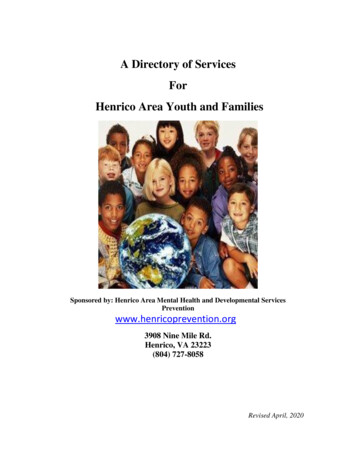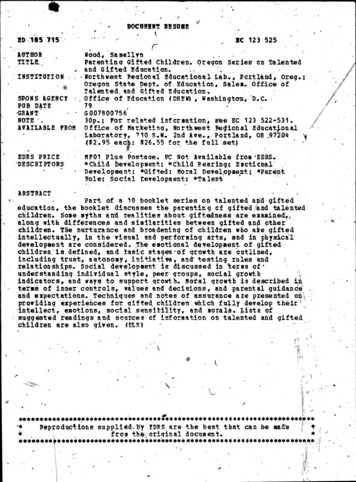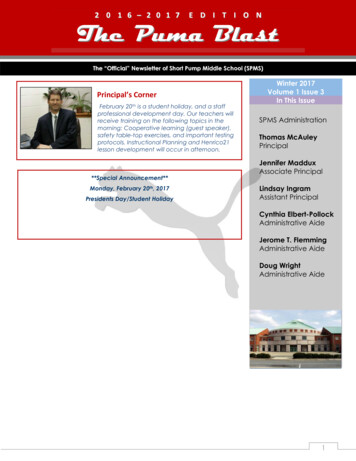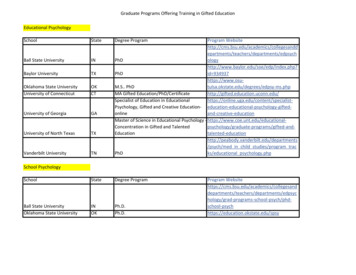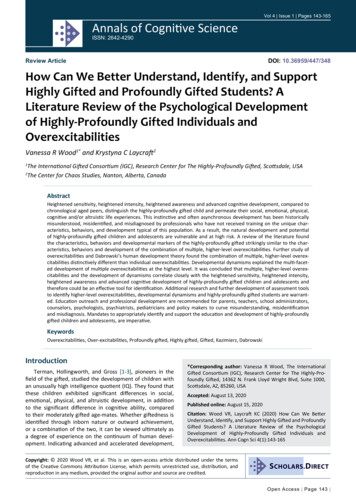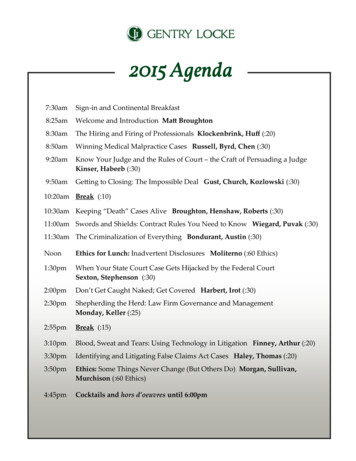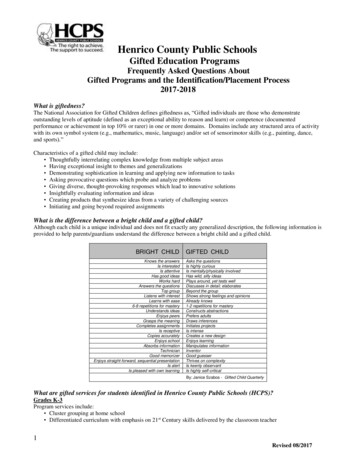
Transcription
Henrico County Public SchoolsGifted Education ProgramsFrequently Asked Questions AboutGifted Programs and the Identification/Placement Process2017-2018What is giftedness?The National Association for Gifted Children defines giftedness as, “Gifted individuals are those who demonstrateoutstanding levels of aptitude (defined as an exceptional ability to reason and learn) or competence (documentedperformance or achievement in top 10% or rarer) in one or more domains. Domains include any structured area of activitywith its own symbol system (e.g., mathematics, music, language) and/or set of sensorimotor skills (e.g., painting, dance,and sports).”Characteristics of a gifted child may include: Thoughtfully interrelating complex knowledge from multiple subject areas Having exceptional insight to themes and generalizations Demonstrating sophistication in learning and applying new information to tasks Asking provocative questions which probe and analyze problems Giving diverse, thought-provoking responses which lead to innovative solutions Insightfully evaluating information and ideas Creating products that synthesize ideas from a variety of challenging sources Initiating and going beyond required assignmentsWhat is the difference between a bright child and a gifted child?Although each child is a unique individual and does not fit exactly any generalized description, the following information isprovided to help parents/guardians understand the difference between a bright child and a gifted child.BRIGHT CHILDKnows the answersIs interestedIs attentiveHas good ideasWorks hardAnswers the questionsTop groupListens with interestLearns with ease6-8 repetitions for masteryUnderstands ideasEnjoys peersGrasps the meaningCompletes assignmentsIs receptiveCopies accuratelyEnjoys schoolAbsorbs informationTechnicianGood memorizerEnjoys straight-forward, sequential presentationIs alertIs pleased with own learningGIFTED CHILDAsks the questionsIs highly curiousIs mentally/physically involvedHas wild, silly ideasPlays around, yet tests wellDiscusses in detail; elaboratesBeyond the groupShows strong feelings and opinionsAlready knows1-2 repetitions for masteryConstructs abstractionsPrefers adultsDraws inferencesInitiates projectsIs intenseCreates a new designEnjoys learningManipulates informationInventorGood guesserThrives on complexityIs keenly observantIs highly self-criticalBy: Janice Szabos - Gifted Child QuarterlyWhat are gifted services for students identified in Henrico County Public Schools (HCPS)?Grades K-3Program services include: Cluster grouping at home school Differentiated curriculum with emphasis on 21st Century skills delivered by the classroom teacher1Revised 08/2017
Extension activities that correlate with the Standards of Learning (SOL) delivered by the classroom teacher or theElementary Gifted Resource Teacher Enrichment activities that reinforce and extend SOL skills and concepts delivered by the classroom teacher or theElementary Gifted Resource Teacher Weekly consultative/support services provided by the Elementary Gifted Resource TeacherGrades 4-5Program services include: Cluster grouping at home school Gifted curriculum & enrichment opportunities emphasizing 21st Century skills delivered by the classroom teacher School Based/*Zone Center Program option Math/Science Innovation Center Saturday Enrichment Classes*Note: Students identified in general intellectual aptitude may only enter the zone center program in September of their fourth or fifthgrade year.Grades 6-12Program services may include: Advanced/accelerated curriculum emphasizing 21st Century skills for Grades 6-8 delivered by the classroom teacher Honors/Advanced Placement/Dual Enrollment courses for Grades 9-12 delivered by the classroom teacher Enrichment classes/seminars emphasizing 21st Century skills for Grades 6-8 delivered by the Secondary GiftedResource Teacher Consultative services for Grades 6-12 delivered by the Secondary Gifted Resource Teacher Summer Governor’s School Academies for Grades 6-12What is the Gifted Identification/Placement Process?Gifted identification is a multistage process designed to find K-12 students attending a HCPS program from variousbackgrounds who are eligible for service options through HCPS gifted education programs. The multiple stages arescreening, referral, and gathering of multiple criteria for the gifted identification/placement process that concludes with thedetermination of eligibility by the school-level Gifted Identification/Placement Team.In what categories may a student attending a HCPS program be screened and referred for academic giftedservices? General Intellectual Aptitude which includes both English/language arts and mathematics (K – Grade 12) Specific Academic Aptitude-English/language arts (K – Grade 12) Specific Academic Aptitude-Mathematics (K – Grade 12)How is the screening process different from the referral process?Screening is the process of reviewing existing, generally available, or specifically designated data for all students todetermine whether students should be referred for the formal identification process. The referral process is the directprocedure that enters a student into the formal identification process.Who may be screened for gifted services?Any K-12 student registered, enrolled, and attending a HCPS program may be screened for gifted services inEnglish/language arts and/or mathematics during the school year.What if a student is currently enrolled in a private school or home school program?Students must be registered, enrolled, and attending a HCPS program in order to be screened and referred for the giftedidentification/placement process during the appropriate timeline listed below.What student information is reviewed during screening?The screening process consists by creating a pool of potential K-12 students who may or may not proceed to the referralprocess with a particular emphasis on underserved populations. The screening process requires instructional personnel toreview, at a minimum, current assessment data on each kindergarten through twelfth-grade student annually. Screeningcriteria may include any of the following sources. Screening Checklists of Gifted Characteristics – Classroom teachers document students’ gifted characteristics andbehaviors. Inquiries – The school’s Gifted Identification Coordinator (GIC) receives inquiries about gifted services fromparent/guardian(s), professional educators, community members, peers, or students. Inquiries must be made byemailing or making a request in writing to the GIC.2Revised 08/2017
Nationally Norm-Referenced Test Scores – The school’s GIC, gifted resource teacher, school principal, orEducational Specialist for Gifted Education Programs reviews students’ ability and/or achievement test scores,with a particular emphasis on scores at the 96th percentile or higher. Records of Identified Transfer Students - The school’s registrar and/or school counseling office notifies theschool’s GIC of students who have been identified for gifted education services in other school divisions.How does a student become referred for the gifted identification process?The referral window for grades 3, 4, 5 begins October 9. Grades K, 1, 2 begins on January 2nd. For information onmiddle school referrals, please contact the middle school gifted resource teacher at the appropriate school. Aparent/guardian, professional educator, community member, self, or peer may refer a student. Referrals are accepted inwriting by the school’s Gifted Identification Coordinator from October 9-27 or January 2-19 for specified grades. Referralsreceived after these dates will be considered during the next appropriate referral window. Parents/Guardians must send anemail or submit a request in writing to the school’s Gifted Identification Coordinator from October 9-27 or January 2-19of the appropriate referral window. The school’s coordinator will send an Academic Referral Form and Parent/GuardianQuestionnaire home to be completed. The questionnaire is also available through the HCPS website. The website link ftedParentGuardianQuestionnaire.pdfWhat initiates the formal identification/placement process?The school’s Gifted Identification Coordinator will send the parent/guardian the Academic Referral Form and the ParentQuestionnaire by November 2 for first semester or January 26 for second semester. The Academic Referral Form must besigned and returned to the school by November 10 or February 2.What student information is gathered and reviewed during the identification/placement process?The following information must be gathered and reviewed: Parent/Guardian Questionnaire with examples Classroom Performance (Professional Rating Scale of Gifted Characteristics with examples) Grades Standardized test scoresThe following information may be gathered and reviewed: Report of student interview/observationWhat is the timeline for the Identification/Placement Team to make a recommendation?Once a signed Academic Referral Form from the parent/guardian has been received by the school’s Gifted IdentificationCoordinator, the school-level Identification/Placement Team has up to 60 instructional days to determine the eligibilitystatus of each student.What if all of the criteria for my child are not available during the 60 instructional days?If all criteria are not available during the 60 instructional day window, the student will be placed on monitor status whilethe additional criteria are collected. Parents will receive a letter stating that their child has been designated as MonitorStatus. The Identification/Placement Team will meet when all criteria is available.What kind of assessments are the Cognitive Abilities Test (CogAT) and the Measures of Academic Progress(MAP) administered by HCPS?The CogAT is an aptitude test. Riverside Publishing states, “The Cognitive Abilities Test (CogAT) measures students’learned reasoning abilities in the three areas most linked to academic success in school: Verbal, Quantitative andNonverbal.”The Northwest Evaluation Association’s (NWEA) computerized *Measures of Academic Progress (MAP) tests areachievement tests which “determines a student’s level of achievement” in reading and math.*Note: HCPS found a strong correlation between the fall administration of the MAP reported percentiles and the fall administration ofthe Iowa Achievement Test and the Stanford Achievement Test. Therefore, only the most current fall MAP scores will be used for theprocess.3Revised 08/2017
What nationally norm-referenced tests scores are utilized for the identification process?English/Language Arts Ability Test: Verbal Battery Ability Test: Nonverbal Battery Ability Test: Composite Score MAP:Reading ScoreMathematics Ability Test: Quantitative Battery Ability Test: Nonverbal Battery Ability Test: Composite Score MAP:Math ScoreNote: A maximum of one supporting test score from the same test may be used for the process. The one score can be: one ability testscore; or one achievement test score from the same test.How is the information evaluated to determine if a student is identified for gifted services?As stated in the Gifted Identification/Placement Procedural Manual, the following criteria must be met:Intellectual Identification- Four criteria supporting identification in English/language arts and- Four criteria supporting identification in mathematicsEnglish/Language Arts Identification- Four criteria to support identificationMathematics Identification- Four criteria to support identificationWhat if a student has aptitude or achievement scores of 95 percentile or lower?A student with aptitude or achievement test scores of 95 percentile or lower needs four criteria supporting identification inEnglish/language arts and four for identification in mathematics.Are nationally norm-referenced test results from other school divisions accepted for transfer students?Test scores are accepted from other school divisions if the scores are within a two-year window from the date the test wasadministered.What other tests may be used for the identification process?For parents seeking testing outside of HCPS, the following individual intelligence assessments administered by a statelicensed psychologist will be accepted: WISC-V Wechsler Intelligence Scale for Children, Stanford-Binet Intelligence Test,Woodcock Johnson Ability Test, and *Cognitive Abilities Test. The report must be on letterhead stationery, signed by thepsychologist and accompanied by a copy of the psychologist’s license. The results must be reported as standard age orgrade national percentile scores.What happens after the information is gathered on a student’s ability and performance?After information is gathered from multiple sources, a meeting of the Identification/Placement Team is scheduled at thestudent’s school. The Identification/Placement Team is comprised of the principal or designee, the school’s GiftedIdentification Coordinator, the school counselor, the classroom teacher(s), and the gifted resource teacher.At the meeting, the Identification/Placement Team shares and discusses the student’s portfolio. The Team makes arecommendation and forwards the student information to the Specialist for Gifted Education Programs for review. Thereview by the Educational Specialist is to ensure consistency of the identification process established by HCPS andcompliance with the Virginia Regulations Governing Educational Services for Gifted Students. Formal notification is sentto the parents/guardians from the school after the Identification/Placement Team’s recommendation is reviewed andapproved by the Educational Specialist.When can a parent/guardian review the evidence in the portfolio?After the formal notification has been sent to the parents/guardians from the school after the Identification/PlacementTeam’s recommendation is reviewed and approved by the Education Specialist, parents/guardians may review theinformation in their child’s portfolio with the school’s Gifted Identification Coordinator or school administrator. No copiesof any information or scored rubrics/checklists will be given to the parent/guardian.4Revised 08/2017
What kinds of recommendations can the Identification/Placement Team make?The types of recommendations that may be made include one of the following: Identified for gifted services in General Intellectual Aptitude (K – Grade 12); Identified for gifted services in English/Language Arts Aptitude (K – Grade 12); Identified for gifted services in Mathematics Aptitude (K – Grade 12); Not identified for gifted services at this time; or Designated as monitor status.If the recommendation is not identified for gifted services at this time, can the student be referred again?Students may be referred only once during the school year within the appropriate timeline for the specific grade level.What if a parent/guardian does not agree with the decision?Parents/guardians receive a copy of the appeal process with formal notification of the decision. Parents/guardians whodisagree with the decision may contact, in writing, the school’s principal. This must be done within five (5) instructionaldays of notification. All decisions made by the Division-Level Appeal Committee are final.Who should parents/guardians contact if they want more information about the process?Parents/Guardians should contact their child’s school to speak with the school’s Gifted Identification Coordinator. Also,parents/guardians may contact the Gifted Education Programs Office at 804.652.3765.Are there websites which provide additional information about HCPS gifted education programs and theidentification/placement process?Three HCPS websites are listed below. HCPS Local Plan for the Education of the Gifted ices/GiftedPlan.pdf Parent/Guardian Questionnaire for the Gifted Identification es/GiftedParentGuardianQuestionnaire.pdf HCPS Gifted Websitehttp://henricoschools.us/gifted/5Revised 08/2017
middle school referrals, please contact the middle school gifted resource teacher at the appropriate school. A parent/guardian, professional educator, community member, self, or peer may refer a student. Referrals are accepted in writing by the school's Gifted Identification Coordinator from October 9-27 or January 2-19 for specified grades.

